Menu
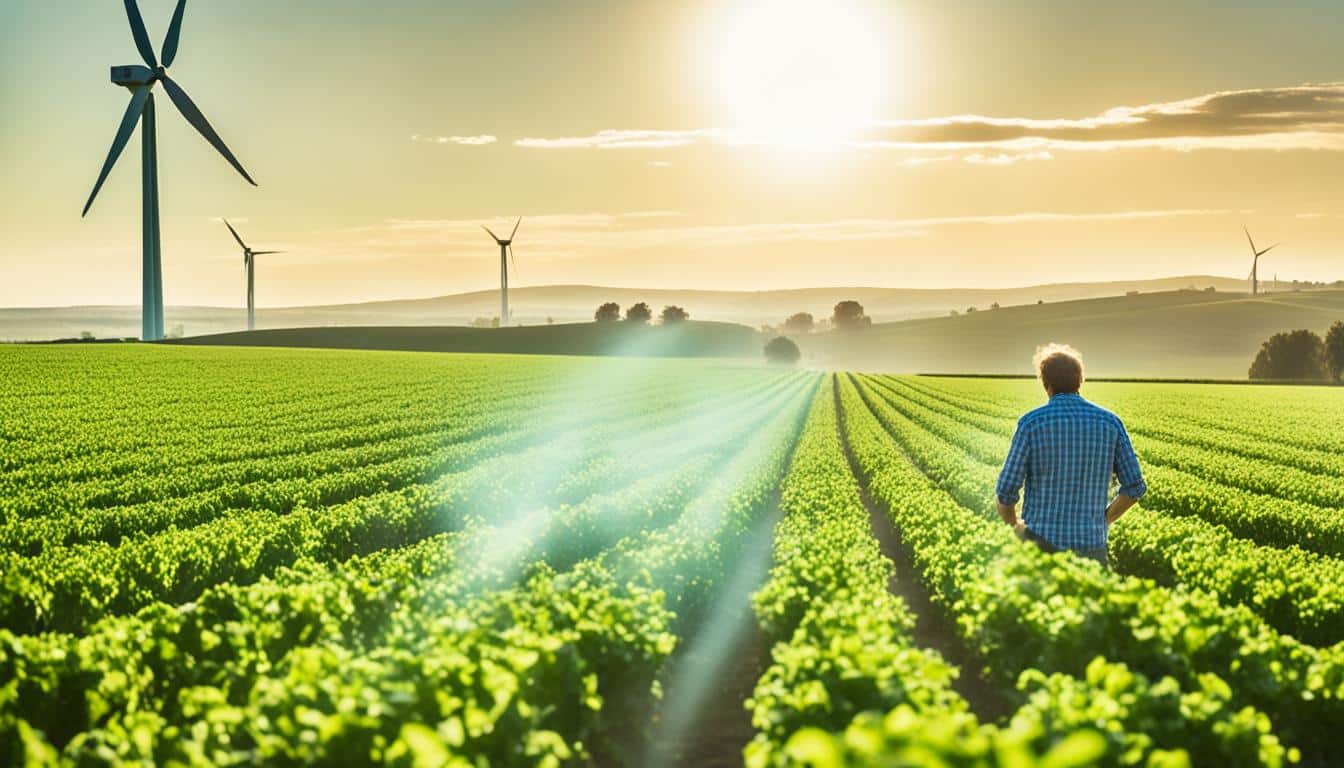
Did you know that one-third of America’s total greenhouse gas emissions come from our food system? This fact shows the urgent need for greener farming. By working together, we can push for big changes in farming and food practices. Getting involved with groups like the National Sustainable Agriculture Coalition (NSAC) can really help. Everyone can make a difference just by talking to lawmakers, whether it’s for five minutes or longer.
Methods like making calls, visiting offices, and joining grant reviews help push green farming forward. It’s also key to share what we learn and achieve. I believe in teaming up for a common goal, which makes our individual efforts very important. This way, we can really change things for the better.
Sustainable farming policies shape the future of our fields. They mix ecological ways with agriculture. This combo helps the economy, keeps nature safe, and shares opportunities fairly. With more people to feed, these ways will be key. Food demand is expected to go up by 70% by 2050.
They boost the economy by doing farming smartly. Things like growing different crops in the same place to changing the animals on a farm make food grow better. This can mean more money for farms. It also helps small farms do well, keeping money in the local area.
Using the land wisely, we protect the environment and farming’s future. There are techniques that stop the land from wearing down. Some ways to farm use less fuel and keep water. Others make the land more alive with plants and trees. All this shows how helping nature can also help us.
Farming helps more than make food. It supports life in the countryside and fairness. Everyone should be able to buy food they need. Making food without harming people or nature is also important. By doing this, life gets better for everyone in the long run.
The need for sustainable farming laws is critical. Farmers rallied in Washington, D.C., through the Farmers for Climate Action group. They pushed for better laws in the Farm Bill, especially for environmental needs.
They wanted more support for organic farming and changing to green methods. Farmers stressed how talking to government members can help make these changes happen.
They also highlighted the importance of spreading good farming methods through research. This push for new and eco-friendly farming is key for the future of agriculture. They said it’s vital to listen to Indigenous and local farming communities to help everyone.
A table shows the main points they talked about:
| Advocacy Aspect | Specific Demands |
|---|---|
| Funding | Permanent climate-focused baseline funding |
| Organic Opportunities | Maximise support for organic producers |
| Technical Assistance | Increase availability and quality for climate-friendly farming |
| Research Programs | Expand to train farmers in best practices |
| Indigenous Prioritisation | Resources for traditional and underserved farmers |
They also called for easier ways to take part in these programs, clearer rules, and fairer access to land. This work with lawmakers ensures that farm laws support the planet and farmers.
We see groups like OFRF working closely with government leaders for positive changes. By joining important events, connections are made. These moments are crucial for promoting sustainable farming.
By trying to cover all the important issues, these groups are shaping agricultural policies. They aim to support farming that is good for the planet and fair for everyone. Although it is hard work, the impact is promising for a better future for farming and our world.
Organic farming in the United States has grown a lot. This is mostly due to more people wanting food that’s produced cleanly and sustainably. The government has made laws to support this change. These laws help farmers switch to organic methods and make the whole industry grow.
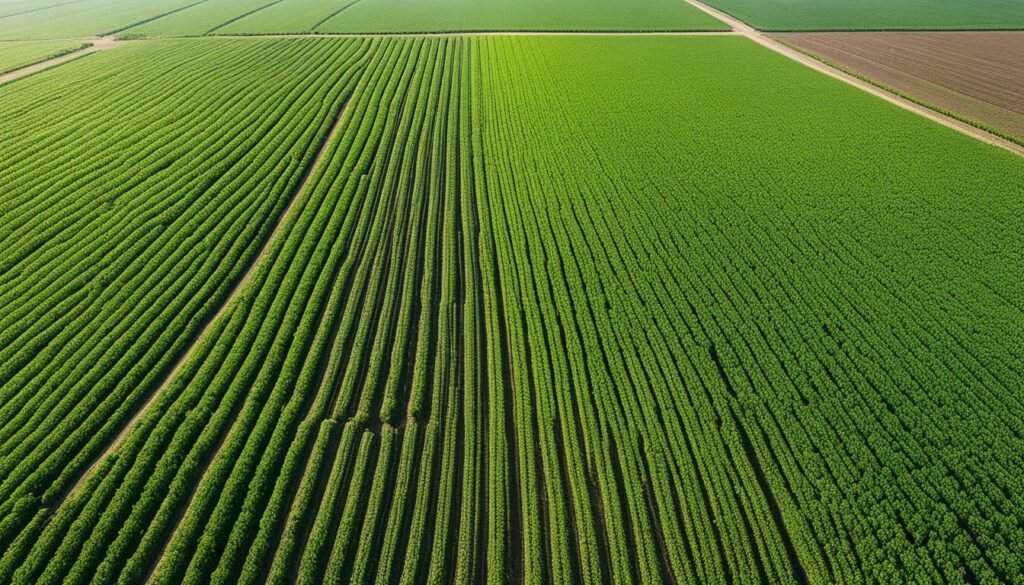
In the 1970s, people began to see the bad effects of using synthetic pesticides and fertilizers. This led to a big increase in organic farming. Now, there are strict standards for what can be called organic. For example, farms must be certified if they earn more than $5,000 a year from their products. This certification helps build trust with consumers.
Although changing to organic farming can be tough and affect the amount of crops in the short term, there are big long-term benefits. These include selling products at higher prices and reaching new markets.
Government rules have helped a lot in the growth of organic farming in the US. The Organic Foods Production Act of 1990 set the first big standards. Since then, more policies have been put in place to support organic farming.
Programs like the National Organic Certification Cost Share Program help farmers financially in getting certified. In the 2018 Farm Bill, a small part of the budget was set aside for organic and local farming support. This shows the government’s commitment to growing the organic food industry.
There are also special initiatives and programs for organic farming research and resources. These efforts help organic farming stay sustainable and keep improving. Hence, the government is not just supporting the business side of organic farming but also ensuring it’s good for the environment.
Policy changes are key to making farming more sustainable. We need to tweak old policies and make new ones focusing on eco-friendly and social practices. This way, we guide farming towards a future that’s better for the planet.
Growing different types of crops is very important. Farms that do this see less damage from pests and grow more crops. By also planting cover crops, they can reduce soil loss by 30%.
Using less soil tillage is another big win against erosion. It can cut down on soil loss by half, beating traditional plowing hands down. Also, using IPM slashes chemical use by almost half, while still keeping pests in check.
Adding animals to farm fields boosts crop yield and drops transport costs. Plus, planting trees along with crops cuts water use by 10% and brings in extra cash from selling fruits and nuts.
Taking care of water and soil is crucial. Better farming methods have led to cleaner water and 20% more crops. They’ve also made farms tougher against bad weather and changing markets, making agriculture more sustainable.
Changing farm policies doesn’t stop at country borders – it’s a worldwide effort. For example, Europe has cut down on fertiliser use since the 1990s by over 40%. China’s smarter use of fertilisers and less subsidies has also made its rivers cleaner.
Looking at the big picture, adjusting farm support can do a lot of good. Redirecting some of the $800 billion given in support each year can help in many ways. It can lower emissions, boost farms, and ease poverty.
That’s why working with groups like the National Sustainable Agriculture Coalition and the National Young Farmers Coalition is vital. These alliances help push for better farming policies and greener practices.
Implementing green farming methods is key for long-term success in agriculture. This means using both local efforts and big policies to encourage smart farming ways. These approaches help the environment and farmers alike, bringing big changes to how we farm.
Farmers are vital in making farms greener. Here are some top ways they can do this:
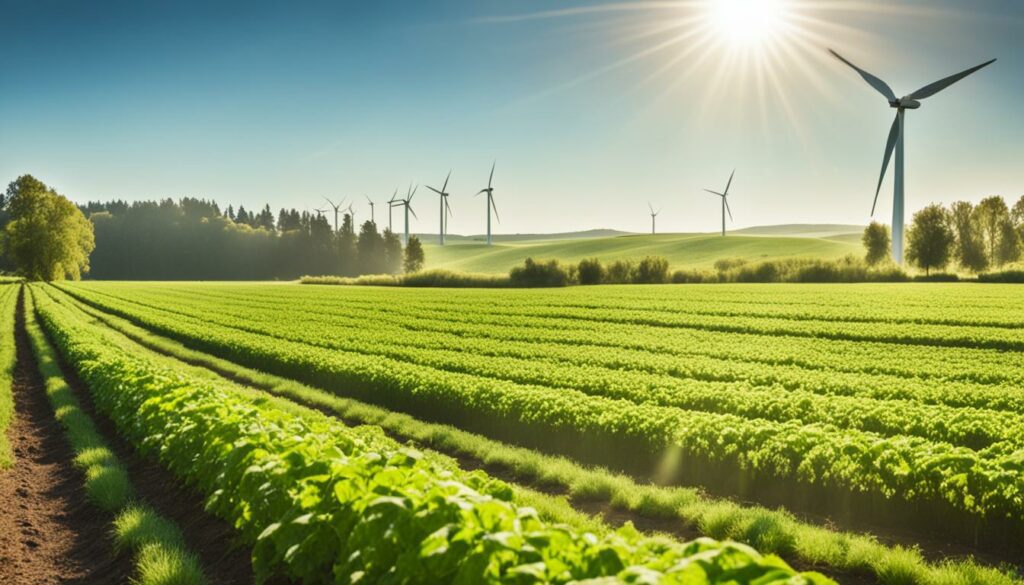
Strong laws and rules are essential to see these great farming methods everywhere. Some suggestions include:
By combining local and big efforts, we can grow food in a way that’s better for the environment and for business.
| Practice | Adoption Rate (%) | Benefits |
|---|---|---|
| Crop Rotation and Diversity | 90% | Enhances soil health, pest control |
| Cover Crops | 75% | Prevents erosion, replenishes nutrients |
| Reduced Tillage | 60% | Maintains soil structure, reduces carbon emissions |
| Integrated Pest Management (IPM) | 80% | Efficient pest control with minimal chemicals |
| Integration of Livestock and Crops | 70% | Enhances efficiency, profitability |
| Agroforestry | 50% | Environmental and economic benefits |
Community advocacy is vital for changing agriculture and including the public in farming policies. Grassroots movements, with the help of people and local groups, influence big policy changes. For instance, Montana could earn $134 million more if it used more local products, as suggested by the Montana Food Economy Initiative.
The AERO project in Montana highlights the need for strong community ties to promote sustainable farming. By using different community strengths, like people, nature, and politics, farmers and advocates build powerful networks. These networks help with changing agriculture and getting the public more involved.
Building these networks also improves lives and the economy of farms. The AERO project offers training to improve how farmers and professionals work together. This improves local food projects and benefits health, wealth, and farming success.
Communities help by raising awareness and support for farming issues. They can influence policies this way. Getting involved through community advocacy ensures that farmers and locals have a say in creating policies that meet their needs.
The future of green farming hinges on new tech. I see how important it is becoming. Innovative tools are changing old ways, making farms more green. Today, farms use clever gadgets, save water, and go for renewable energy. This makes farming better for the planet.
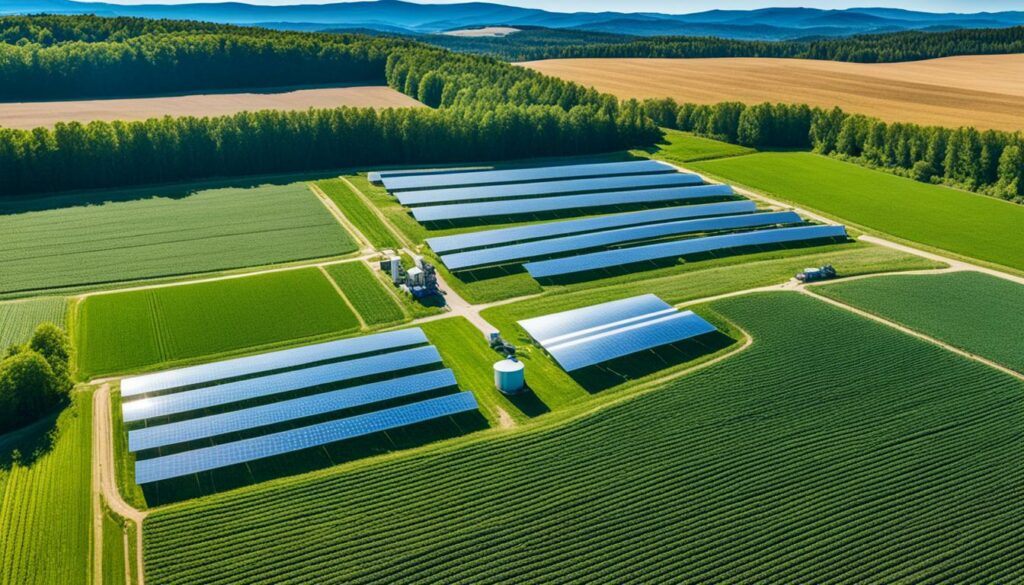
New farm tech is turning heads. Take precision agriculture, for example. By using data and smart planning, it saves on planting and watering. This means less waste and better use of resources. Also, there are smart ways to save water. Drip irrigation and collecting rain save a lot of water. Using solar and wind energy helps too. It cuts back on pollution and saves money.
Looking at past wins can help us all do better. For example, the NESAWG showed how to farm without hurting nature. They used smart pest control and farming methods. In Mexico, the “MasAgro” project is a great success. It shows how using less chemical and more trees helps farmers.
There’s the SRI method for rice, too. It lets fields produce more with less water and chemicals. These stories show us what’s possible. They push us to make big changes in farming for the good of our planet.
| Technology | Benefits | Example Initiatives |
|---|---|---|
| Precision Agriculture | Optimises resource use, reduces waste | MasAgro, NESAWG |
| Water Management | Conserves water, maintains yields | Drip Irrigation Systems, SRI Method |
| Renewable Energy | Reduces carbon footprint, lowers energy costs | Solar and Wind Power on Farms |
Creating green farming laws is key to making agriculture sustainable. These rules help prevent damage to the environment. They’re important because a third of the country’s greenhouse gases come from farming. So, we need these laws to reduce pollution and promote eco-friendly farming.
Today, a lot of tax money goes towards harmful farming. This includes large animal farms, biofuels that harm the climate, and unhealthy food. By putting strict rules in place, we can use this money to help farmers do better. They’ll be encouraged to use safer and greener ways to farm.
Many people are looking to change farming laws for the better. Groups like Earthjustice have succeeded in making the food and farming industry cleaner through the law. They show why we need laws that help farmers use new ideas and protect the environment.
Farming in green ways, like planting different crops each season, helps keep the soil healthy and uses less water. It also means we use fewer chemicals in farming. For example, planting certain cover crops can mean less need for man-made fertilisers, which is good for the Earth.
Using nature to control pests and taking care of the land helps keep everything in balance. This eco-friendly way of farming makes the environment stronger against things like climate change. It’s all about working with nature, not against it.
| Aspect | Impact |
|---|---|
| Greenhouse Gas Emissions | Reduction of one-third of emissions from the food system |
| Water Usage | Minimised waste through drip irrigation and water recycling |
| Soil Health | Improvement through crop rotation and cover cropping |
| Pest Control | Reduced reliance on chemical pesticides via IPM techniques |
| Biodiversity | Enhanced through agroecology and crop diversity |
| Carbon Sequestration | Increased soil organic carbon stocks through reduced tillage |
Taking care of farm animals and managing their waste is also vital. Laws should ensure animals are treated well, food is sourced responsibly, and waste is handled right. This is important for farming that helps local areas and makes farming less harmful to the planet.
We need eco-friendly rules to protect our environment and keep farming going. Lawmakers should make following these rules a top priority. This way, farming can be good for nature, the economy, and society, and meet global environmental goals.
Looking at how different places manage land shows us what works. From international examples to local success stories, many have figured out what makes for lasting and successful farming. This knowledge can guide others towards a more sustainable future in agriculture.
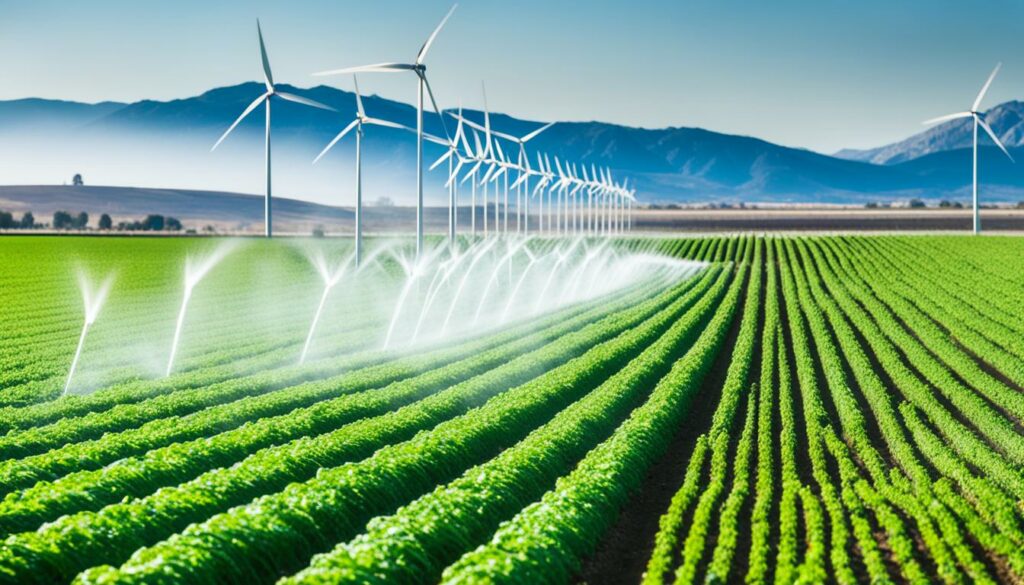
Countries have their own ways of using the land well without harming it. Take the Netherlands for example. They’re good at making the most of their land without hurting it. They do this by using smart methods for farming, protecting the soil, and watering the fields. Then there’s Costa Rica, known for its efforts in planting trees and mix-cropping. These activities keep nature diverse and help the Earth.
“In Rwanda, post-genocide land reforms have paved the way for sustainable practices such as terracing and agroforestry, enhancing both agricultural output and environmental health.”
Denmark looks after its land by avoiding harsh chemicals in farming. They also rotate what they grow, which keeps the ground and water in good shape. Bhutan takes a traditional approach, using organic methods and protecting its forests. This care for nature is deeply linked to their way of life.
Closer to home, areas like China succeed by re-growing forests and building walls on hills. These steps fight off the spread of deserts and keep the soil in place. In places like Gothenburg and Munich, smart city planning and lots of green spaces are making a big difference. These places show us that getting the community involved and good public transport are key to making cities green and liveable.
There are many benefits in farming the right way. For example, changing what you plant each season and growing a mix of crops can make the soil healthier and control pests better. If you plant certain crops between your main ones, the soil won’t wash away as much and you’ll need fewer chemicals to grow your food.
| Country/Region | Key Practices | Outcomes |
|---|---|---|
| Netherlands | Precision farming, advanced irrigation | Increased efficiency, soil conservation |
| Costa Rica | Reforestation, agroforestry | Enhanced biodiversity, ecosystem services |
| Rwanda | Terracing, agroforestry | Improved land use, environmental health |
| Denmark | Organic farming, crop rotation | Enhanced soil health, water quality |
| China (selected regions) | Reforestation, terracing | Combated desertification, reduced soil erosion |
| Gothenburg & Munich | Urban planning, green solutions | Sustainable urban development |
“`
This piece brings together key ideas like good farming practices and successful cases from around the world. It shares important insights while being easy to follow, making sure everyone learns about keeping our land safe and productive. The use of details and the table help you really get why sustainable land use is a big deal.
The National Sustainable Agriculture Coalition (NSAC) is powerful in changing farm policies for the better. It pushes for a national plan that promotes sustainable farming laws. The NSAC’s work has influenced how money is used and what programs get focus from the Agriculture Improvement Act of 2018.
The 2018 Farm Bill is a huge plan costing $428 billion over five years. But, only a small part, less than $5 billion, goes to key programs like the Local Agriculture Market Program and the Farming Opportunities Training. Thanks to the NSAC, these funds support sustainable farming well.
The NSAC doesn’t only watch how money is spent, it is part of all Farm Bill steps. It helps in rewriting the bill, speaks at hearings, and works with government committees. Its mix of public voice and behind-the-scenes work wins more money for programs like the Agricultural Conservation Easement Program (ACEP).
The NSAC also fights for better rights for farm and food workers and stronger rules to protect the environment. It has achieved some wins, like the Rural Energy for America Program (REAP) and the Local Agriculture Market Program, showing it wants big changes in farming laws.
| Program | Funding Allocation | NSAC Impact |
|---|---|---|
| Agricultural Conservation Easement Program (ACEP) | $450 million per year | Increased funding for ACEP |
| Conservation Technical Assistance (CTA) | $874.1 million in FY 2019 | Expanded technical assistance |
| Local Agriculture Market Program (LAMP) | $50 million per year | Ensured continuous funding |
| Rural Energy for America Program (REAP) | Protected mandatory funding | Sustained renewable energy adoption |
The NSAC shows us how smart advocacy can make big changes in farming laws. This helps the environment, the economy, and our communities.
Farmers are key in promoting agricultural sustainability measures. They can do this through action and using social media carefully. By spreading the word, they can improve soil health, control pests better, and make farms more effective.
Being in local talks and joining policy meetings help farmers guide sustainability rules. They show how methods like mixed planting and using certain crops help the environment. Sharing the benefits of no-dig farming, smart pest control, and combining trees with crops also makes a big difference.
Also, teaching workshops or showing demonstrations in their area can educate others on the value of changing farming methods. This promotes a broad movement towards farming that lasts longer. It shows how smartly designing what you grow and looking after the land can make a farm work better.

Online, farmers can spread the word big time. Platforms like Twitter, Facebook, and Instagram are great for telling good stories, sharing new ideas, and updates on sustainable farming. This educates others and brings farmers together with people who also care about making farming better.
Using social media, they can also draw attention to generating clean energy on farms, like with solar panels. They can stress farming methods that reduce carbon too. Talking about lessening how much gas cows emit and how grasslands trap harmful carbon can change what people think and do. Social media is a powerful tool to unite for agricultural sustainability measures.
Combining direct actions with strategic social media use can thus profoundly impact the sustainability of agricultural practices, both locally and nationally.
Working together with partner organisations is key to making big changes in farming policies. It helps bring about sustainable ways of farming in a significant manner.
Joining forces with NGOs in the farming sector offers much needed help and knowledge. This includes a mix of resources from government bodies, charities, and businesses. Such mixes can make a difference in saving the environment, helping rural areas grow, and ensuring there’s enough food for everyone. Take the example of Grupo Bimbo and CIMMYT’s efforts. They’ve worked together to switch over 14,800 hectares to farming practices that are good for the land.
Using national networks for farming lets us gather public and private money for good causes. Connections between the government, schools, and farming businesses help introduce new tech like smart farming and biotechnology. These partnerships also make policies from public-private groups (PPPs) stronger. They help build a farming sector that’s ready for the future and looks out for everyone.
| Company | Initiative | Acreage | Year |
|---|---|---|---|
| PepsiCo | Regenerative farming practices | 7 million | 2030 |
| Walmart | Regenerative farming practices | 30 million | Midwest Region |
| General Mills | Regenerative farming | 1 million | 2030 |
| Unilever | Investment in regenerative agriculture | – | €100 million |
| VF Corporation | Regenerative cotton farming | 1 million | U.S. |
Through these big networks, everyone can combine their strengths. This pushes the farming strategy towards sustainability. It shows a common effort in tackling important issues and putting in place plans that make farming better and safer for the future.
In recent years, climate change policies have become vital for sustainable farming. They help deal with severe weather changes like more floods, droughts, and heatwaves. These rules are important because they guide farmers to cope with new threats, such as pests and diseases, because of the rising heat.

Many effective farming methods come from ancient traditions. These practices have been around for thousands of years. The National Sustainable Agriculture Coalition (NSAC) helps promote these sustainable farming methods to fight climate change.
NSAC believes in diverse and resilient farming that’s also kind to the environment and people. It promotes practices like organic farming. Organic farming is good for fighting climate change, showing us how helpful supportive climate policies are.
The next farm bill is a critical opportunity to address climate change in agriculture by providing necessary resources like funding, research initiatives, and risk management tools for climate-friendly farming practices.
Looking back, the farming industry has a rough past with the land theft and using slavery. Because of this, climate policies must be fair. They should help both big and small farmers adapt sustainably. This fairness is crucial for a strong farming future.
The views on climate change among dairy farmers vary a lot. This shows the need for different policies to meet every community’s needs. Tailoring these policies can help all farmers face the challenges ahead.
Equitable climate policies that encourage farming to produce energy and store carbon are essential. These policies will help farming not just survive climate change but also help the environment. They will ensure a bright future for farming.
Rural areas strongly support climate policies. This shows the importance of strategies that give money for adapting to climate change and keep doing research. These steps will build a strong and lasting farming community.
The benefits of sustainable farming are vital to share with everyone. It’s crucial to make sure everyone knows about them. This way, they will recognise and support the good things sustainable farming does for the economy, the planet, and society at large.
Getting the message out about sustainable farming is key. We reach people through many ways, like talks, leaflets, and social media. We also work closely with local groups and farmers to really be heard in different areas.
Teaching about sustainable farming is a big step for the future. Starting with schools, the youth learns about these important practices. The collaboration with experts and online resources makes this knowledge fun and easy to understand. It also introduces cool tech like AI, biotech, and drones to everyone.
A solid mix of talking to people and educating them makes a big difference. Together, these efforts make sure sustainable farming is a goal for us all. This way, we help both people and the planet by farming in ways that are friendly to the environment.
Sustainable farming policies are hugely important. They affect the health of the environment, our economy, and fairness among people. These factors help mould a farming industry ready to face changing times, such as with the impact of climate change.
To make farming sustainable needs work from many. This includes researchers, farmers, leaders, and us, the consumers. Together, we are pushing for methods to keep food supply safe for the future. These efforts focus on making farming better at growing crops and dealing with changes in the environment.
The results of bad farming in the past were devastating. They caused soil problems, water harm, and a loss in animal and plant life. On the other hand, choosing to farm in a sustainable way can save nature. It means using water well and clean energy. This also stops the overuse of dangerous chemicals, which helps wildlife. We all play a part in choosing a farming future that helps rather than harms our world and everyone in it.
Sustainable farming policies boost the economy of farming. They ensure long-term success and cut costs. This is done by using resources better.
They aim to protect nature by farming in a way that keeps ecosystems healthy. This helps biodiversity and the soil. The goal is to not harm the environment.
Sustainable farming helps communities by keeping rural jobs, supporting fair food, and taking care of the land. It makes sure communities stay strong and green.
To talk to law makers, you can reach out to them, get involved in making farming laws, go to meetings, or use social media to call for change. Your efforts can make laws more green.
People want healthy, green food, so they buy organic products more. Laws have helped too. They give organic farmers what they need to grow and succeed.
Laws help organic farming stay green, make money, and grow. They push for farming that’s good for nature and people. This is making things better for everybody.
By changing and making new laws, we can help farming become greener and more fair. Working with groups that push for these changes is very important for this.
Rotate crops, use natural ways to fight pests, and save the soil with careful tilling. Sharing these methods and changing laws to encourage them can make farming greener.
When people work together locally, they can really change laws. They get others to support their cause and to understand why it’s important. This leads to real changes.
New farm tech like smart farming, saving water, and using clean energy are making farming more sustainable. These tools are key for a greener farming future.
Laws on green farming make sure nature is protected and that resources are used well. They make sure farms follow green rules. This is good for the environment.
Places around the world show that green farming works. They all focus on growing different crops, saving the soil, and taking care of nature. These methods are proven.
The NSAC helps set a green farming agenda by studying, uniting, and engaging in making laws. It is key in changing farm policies to be more sustainable.
Farmers can speak out in their communities, meet up with policy makers, and show the importance of green farming on social media. This lets them share their ideas and build support.
Working with NGOs and networks, farmers can push for laws that make farming greener and fairer. Joining forces is essential for pushing the green farming agenda forward.
Good climate laws help farming fight climate change and be greener. They help the land and farming deal with climate issues better. Green farming is good for the planet.
To get more people on board, use public talks and learning campaigns. These can reach many and get people involved in supporting sustainable farming.